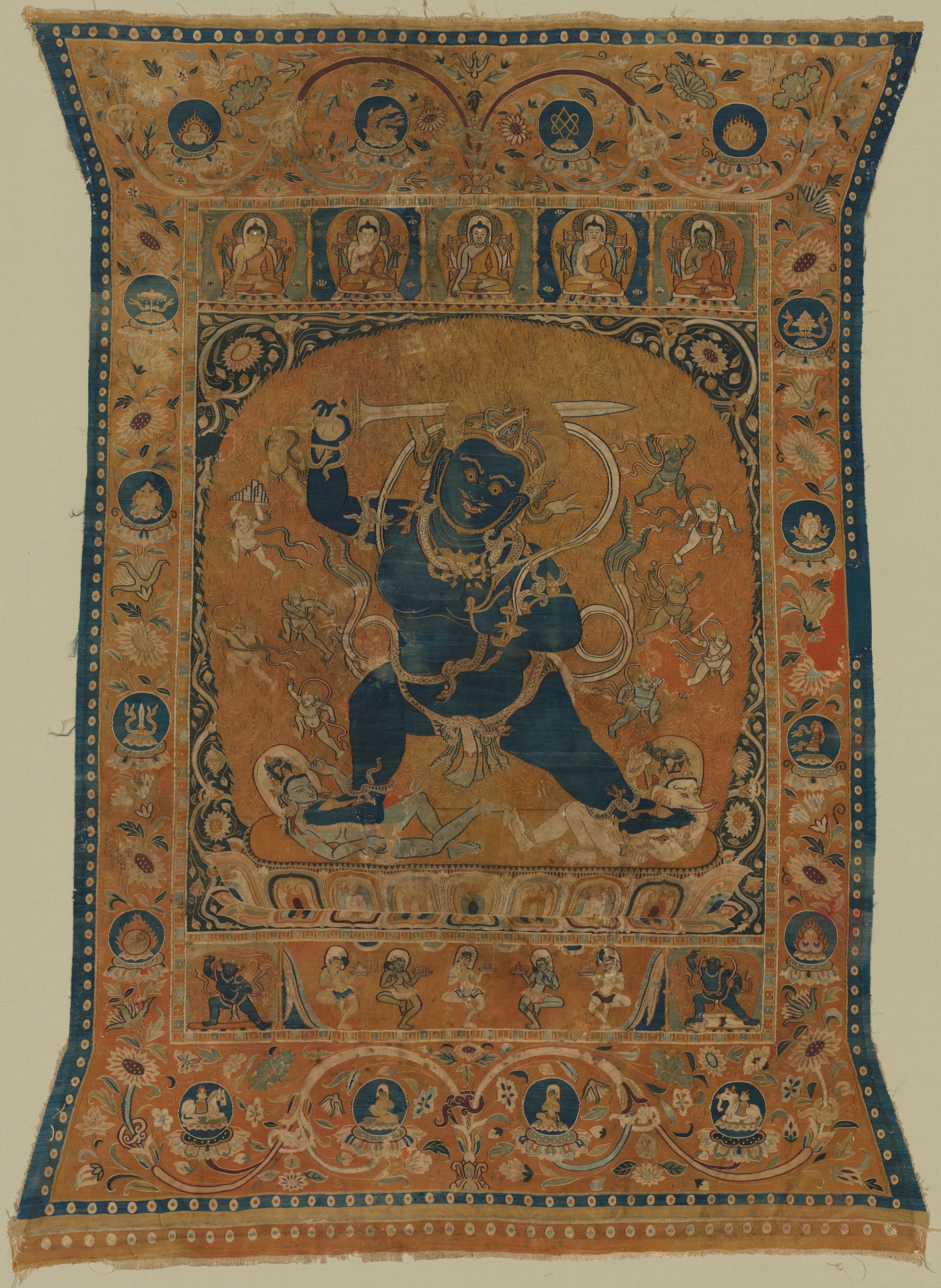The Cleveland Museum of Art
Collection Online as of April 19, 2024

Achala, King of the Wrathful Ones, as Vighnantaka
early 1200s
(1032–1227)
Overall: 100.6 x 74.3 cm (39 5/8 x 29 1/4 in.); Mounted: 111.1 x 83.8 x 7 cm (43 3/4 x 33 x 2 3/4 in.)
Location: not on view
Did You Know?
The Tanguts employed Uyghur weavers to create tapestry thangkas.Description
Close ties between the Buddhists of the Central Asian Tangut Xia kingdom and Tibetan monasteries resulted in works of devotional art, such as this tangka, featuring a remover of obstacles. The imagery has its roots in Nepal, where a protector was summoned by a powerful practitioner to defeat the Hindu god Ganesha, who was disturbing the proper performance of a tantric Buddhist ritual. For this reason, Ganesha and his father Shiva are being trampled under the feet of this figure. Known as Vighnantaka, he is an emanation of the Buddha Akshobhya, who is blue in color and is invoked to aid in quelling anger. This Buddha appears in his crown and as the central figure among the group of five transcendent Buddhas, who are fundamental in tantric Buddhism, depicted above the main image. Among the Tangut people, however, the blue Achala wielding a sword was the main protector, and appears merged with Vignantaka in this image. This rare Tangut tangka is one of few to survive from the period preceding the Mongol conquest of the region in 1227.- ?–1992(Sara Tremayne, Ltd., London, England, sold to the Cleveland Museum of Art)1992–The Cleveland Museum of Art, Cleveland, OH
- Turner, Evan H. "The Year in Review for 1992." The Bulletin of the Cleveland Museum of Art 80, no. 2 (1993): 38–79. Reproduced: pp. 43–44; Mentioned: p. 43, 77 www.jstor.orgWardwell, Anne E. "The "Kesi Thangka" of Vighnāntaka." The Bulletin of the Cleveland Museum of Art 80, no. 4 (1993): 136–39. Reproduced: p. 136; Mentioned: pp. 137–39 www.jstor.org"1993 Annual Report." The Bulletin of the Cleveland Museum of Art 81, no. 6 (1994): 143–218. Mentioned: p. 154 www.jstor.orgWardell, Anne E., "When Silk Was Gold", Cleveland Museum of Art. Cleveland Art: The Cleveland Museum of Art Members Magazine. Vol. 37 no. 08, October 1997 Mentioned and Reproduced: pp. 4–5 archive.orgWatt, James C. Y., Anne E. Wardwell, and Morris Rossabi. When silk was gold: Central Asian and Chinese textiles. New York: Metropolitan Museum of Art in cooperation with the Cleveland Museum of Art: Distributed by H.N. Abrams, 1997. Mentioned: cat. no. 24, pp. 90–94; Reproduced: p. 91, color detail p. 94; b&w detail p. 92; detail of reverse figure 17, p. 59Cunningham, Michael R., Stanislaw J. Czuma, Anne E. Wardwell, and J. Keith Wilson. Masterworks of Asian Art. Cleveland, OH: The Cleveland Museum of Art, 1998. Reproduced: pp. 62–63Amy Heller, "On the Development of the Iconography of Acala and Vighnantaka in Tibet," in Embodying Wisdom: Art, Text, and Interpretation in the History of Esoteric Buddhism. Rob Linrothe and Henrik Sorensen, eds. Copenhagen: Seminar for Buddhist Studies, 2001."Highlights from North American Collections." IDP News: Newsletter of the International Dunhuang Project, no. 49-50, Summer 2017, pp. 4–7. Mentioned: p. 6Debreczeny, Karl. Faith and Empire: Art and Politics in Tibetan Buddhism. New York, NY: Rubin Museum of Art, 2019. Reproduced: fig. 4.7, 4.8, 4.9 and 4.10, pp. 82–83, 94–97Debreczeny, Karl. "Faith and Empire: Art, Power and the Right to Rule." Orientations 50, no. 2 (March/April 2019):114–123. Mentioned: p. 115, Reproduced: p. 116, fig. 3
- Faith and Empire: Art and Politics in Tibetan Buddhism. Rubin Museum of Art, New York, NY (organizer) (February 1-July 15, 2019).Himalayan art rotation. The Cleveland Museum of Art, Cleveland, OH (organizer) (December 22, 2014-November 2, 2015).When Silk Was Gold: Central Asian & Chinese Textiles from the Cleveland and Metropolitan Museums of Art. The Cleveland Museum of Art, Cleveland, OH (October 26, 1997-January 4, 1998); The Cleveland Museum of Art, Cleveland, OH (October 26, 1997-January 4, 1998); The Metropolitan Museum of Art (organizer) (March 2-May 17, 1998); The Metropolitan Museum of Art (organizer) (March 2-May 17, 1998).Selected Acquisitions. The Cleveland Museum of Art, Cleveland, OH (organizer) (February 9-April 11, 1993).
- {{cite web|title=Achala, King of the Wrathful Ones, as Vighnantaka|url=false|author=|year=early 1200s|access-date=19 April 2024|publisher=Cleveland Museum of Art}}
Source URL:
https://www.clevelandart.org/art/1992.72